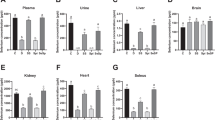Abstract
The purpose of this study was to investigate the ameliorating effects of dietary copper supplementation on selenium toxicity. Nine groups (n=6) of weanling Fischer 344 female rats were randomly assigned to treatment groups and fed diets containing nontoxic levels of copper as CuCl2 and/or selenium as selenite or selenocystamine. Weight gain, liver and spleen weights, plasma lipid peroxidation, and liver selenium and copper content were analyzed after the 6-wk treatment period. Concentrations of up to 10 times the daily lethal dose of dietary selenium were well tolerated in rats supplemented with dietary copper. As the dietary level of selenium was increased, the ratio of selenium to copper measured in the liver decreased. In the groups of rats in which dietary copper supplementation was absent and dietary selenium was supplemented, copper stores in the liver remained unchanged from control values. Copper’s protective effects from dietary selenium toxicity may come from the formation of a copper-selenide complex that renders both selenium and copper metabolically unavailable and nontoxic.
Similar content being viewed by others
References
C. H. Hill, Reversal of selenium toxicity in chicks by mercury, copper and cadmium, J. Nutr. 104, 593 (1974).
L. Jensen, Precipitation of a selenium deficiency by high dietary levels of copper and zinc, Proc. Soc. Biol. Med. 149, 113 (1975).
W. Kezhou, H. D. Stowe, A. M. House, K. Chou, and T. Thiel, Comparison of cupric and sulfate ion effects on chronic selenosis in rats, J. Anim. Sci. 64, 1467–1475 (1987).
H. D. Stowe, Effects of copper pretreatment upon the toxicity of selenium in ponies, Am. J. Vet. Res. 41, 1925 (1980).
H. D. Stowe and P. H. LeBlanc, Effects of cupric sulfate on chronic oral selenosis in rats, Proc. Conf. Res. Workers Anim. Disease, Chicago (1980).
M. A. Amer, G. J. St. Laurent, and G. J. Brisson, Supplemental copper and selenium for calves: effects upon ceruloplasmin activity and liver copper concentration, Can. J. Physiol. Pharmacol. 51, 649–653 (1973).
G. G. Thomas and B. M. Lawson, Copper and selenium interaction in sheep, NZ Vet. J. 18, 79–82 (1970).
P. T. Gleed, W. M. Allen, C. B. Mallison, et al., Effects of selenium and copper supplementation on the growth of beef steers, Vet. Res. 113, 388–392 (1983).
W. T. Buckley, S. N. Hucklin, I. J. Fisher, et al., Effects of selenium supplementation on copper metabolism in dairy cows, Can. J. Anim. Sci. 66, 1009–1018 (1986).
M. B. Kadiiska, P. M. Hanna, S. J. Jordan, and R. P. Mason, Electron spin resonance evidence for free radical generation in copper-treated vitamin E- and selenium-deficient rats: in vivo spin-trapping investigation, Mol. Pharmacol. 44, 222–227 (1993).
M. G. Cherian and R. A. Goyer, Metallothiones and their role in the metabolism and toxicity of metals, Life Sci. 23, 1–10 (1978).
R. L. Davis and J. R. Spallholz, Inhibition of selenite-catalyzed superoxide generation and formation of elemental selenium (Se°) by copper, zinc, and aurintricarboxylic acid (ATA), Biochem. Pharmacol. 51, 1015–1020 (1996).
K. Yagi, Assay for blood plasma or serum, Methods Enzymol. 105, 328–331 (1984).
J. E. Spallholz, G. R. Collins, and K. Schwarz, A single test-tube method for the fluoremetric microdetermination of selenium, Bioinorg. Chem. 9, 435–459 (1978).
S. Vadhanavikit and H. E. Ganther, Nutritional availability and chronic toxicity of selenocyanate in the rat, J. Nutr. 118, 718–722 (1988).
J. E. Spallholz and A. Raffery, in Selenium in Biology and Medicine, AVI, Westport, CT, pp. 516–529 (1987).
K. Schwarz and K. D. Pathak, The biological essentiality of selenium, and the development of biologically active organoselenium compounds of minimum toxicity, Chem. Scripta 8A, 85–95 (1975).
R. F. Burk, Recent developments in trace element metabolism and function: new roles of selenium in nutrition, J. Nutr. 119, 1051–1054 (1989).
Author information
Authors and Affiliations
Rights and permissions
About this article
Cite this article
Tatum, L., Shankar, P., Boylan, L.M. et al. Effect of dietary copper on selenium toxicity in Fischer 344 rats. Biol Trace Elem Res 77, 241–249 (2000). https://doi.org/10.1385/BTER:77:3:241
Received:
Accepted:
Issue Date:
DOI: https://doi.org/10.1385/BTER:77:3:241




